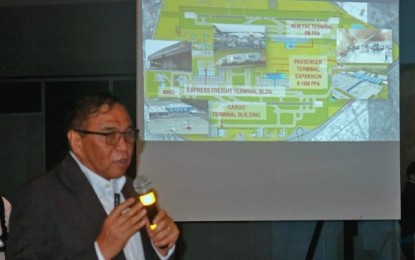
NORTH LUZON ROADSHOW. Clark International Airport Corporation (CIAC) President and CEO Alexander Cauguiran briefs tourism stakeholders in Baguio City during the airport's Clark North Luzon Roadshow on Friday (June 15, 2018) on the development plans of Clark Airport to meet the growing number travelers in the country. Cauguiran expresses hope that travelers from northern Philippines will patronize the Clark gateway. (Photo by Liza T. Agoot)
BAGUIO CITY — The Clark International Airport Corporation (CIAC) conducted a roadshow in Baguio on Friday to drum up interest from the tourism industry in northern Philippines, especially on the use of the Clark airport as a gateway.
CIAC President and Chief Executive Officer Alexander Cauguiran said the Clark airport is implementing a four-phase development program worth PHP17 billion to further improve its facilities for the convenience of the millions of passengers using the airport.
“We expect the growth in travel in the next five years,” he said, stressing that Clark wants to be prepared.
Cauguiran said the Ninoy Aquino International Airport (NAIA) terminals 1 to 4, which were designed for 30 million passengers, overshoot its target in 2017 with 43 million passengers.
Domestic travelers, he noted, are projected to increase by 15 percent, and international tourists by 10 percent, in the next five years.
He estimated this would mean an additional four million passengers for NAIA alone.
“This trend will make Clark airport a very important facility in north Luzon,” Cauguiran pointed out.
On Friday alone, he said that four planes were diverted by NAIA to Clark due to visibility problem in Metro Manila.
4-phase development plan
Cauguiran said Clark airport's development plan is set to be completed before President Rodrigo Duterte ends his term in 2022.
Phase 1 started in December 2017, covering five components--a terminal that will raise the airport's capacity to eight million per year, an access way to the terminal, the secondary access way that will allow vehicles coming from the Subic–Clark–Tarlac Expressway (SCTEX) to reach the airport terminal without entering the Clark economic zone, a separate building where fetchers can stay, and a huge parking area.
The succeeding phases, Cauguiran elaborated, would further raise the terminal’s capacity to 22 million passengers, then to 46 million, and eventually to 80 million.
The phases would be done in modules, he said, and are set to be operational by the second quarter of 2020.
There will also be a cargo terminal separate from the passengers, and a hangar for private planes, Cauguiran added.
A new runway about one kilometer apart from the existing ones would also allow planes to take off and land simultaneously, he said.
Cauguiran said Clark's civil aviation complex has ample space of 2,367 hectares, four times NAIA'S 600 hectares, making Clark's airport development plan feasible.
Serving northern Philippines
Named Diosdado Macapagal International Airport, the airport in Clark, Pampanga in Region 3 serves travelers from Regions 1, 2, 3 and the Cordillera aside from the cities of Caloocan, Malabon, Novaliches, and Valenzuela (CAMANAVA) in the National Capital Region.
These areas have a total population of over 24 million, Caguiran said, adding the traveling population is bound to grow further.
Clark, he added, is now easy to reach with the Point to Point (P2P) buses that bring passengers from Metro Manila, Baguio City, Nueva Ecija, and Baler town in Aurora province to Clark and vice versa.
He expressed hope that with the Clark airport's proximity to Regions 1, 2, 3, and the Cordillera, more travelers from the northern Philippines will use the facility for their international and domestic trips.
He said that from five to seven flight destinations from Clark a year ago, the airport now has 21 domestic destinations, with 32 planes flying out of Clark daily.
These are aside from the international flights and cargo planes, he said.
Caguiran further revealed that budget Malaysian airline, Air Asia, plans to locate 16 additional planes in Clark in the next five years. These are for the airline's 16 international and 22 domestic flights.
“There is nowhere to go but to improve the facility and enhance the services to cope with the growing demand of air travel,” the aviation executive said. (PNA)
